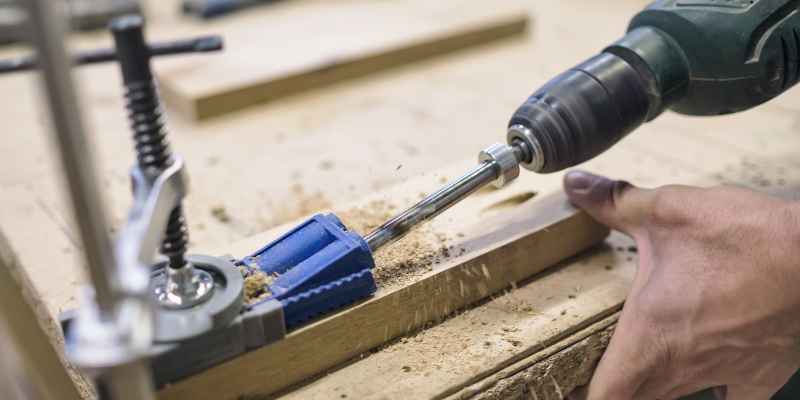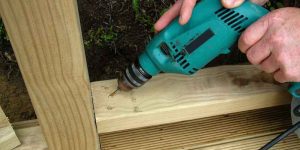Yes, using Kreg Screws is recommended for pocket hole joinery because they are specifically designed for this technique. However, you can also use other types of screws as long as they are appropriate for the thickness and type of wood you are working with.
Keep in mind that using incompatible screws may cause the wood to split or weaken the joint over time. Pocket holes are a popular joinery method in woodworking and furniture-making, allowing you to discreetly join two boards together without visible fasteners.
We will explore the importance of using appropriate screws for pocket holes and some alternatives to Kreg Screws. We will also discuss the benefits and limitations of pocket hole joinery and provide some tips for achieving strong and durable joints.
Introduction To Pocket Hole Joinery
While Kreg screws are specifically designed for pocket hole joinery, you can use other types of screws as long as they are self-tapping and thread their own holes. However, Kreg screws have advantages such as their design and material for optimal strength and longevity.
Pocket hole joinery is a popular woodworking technique that involves drilling an angled hole into a workpiece and then joining it to another workpiece with a self-tapping screw. Pocket hole joinery is a versatile and straightforward technique that can be used for various applications, including furniture, cabinets, and other woodworking projects.
Applications Of Pocket Hole Joinery
Pocket hole joinery is commonly used to make furniture like tables, chairs and bed frames. Pocket holes can be used to attach table legs, chair rails, and bed frames, providing sturdy, hidden joints. Pocket hole joinery is also used in cabinet construction to connect the sides, bottom, and top. Additionally, pocket hole joinery can be used to fix or glue joints and reinforce fasteners. It’s a versatile technique that can be used for a wide variety of woodworking projects.
Avoiding Wood Splitting
One of the most notable advantages of pocket hole joinery is that it avoids the issue of wood splitting that can occur with other joining methods. Since the pocket holes are drilled at an angle, the self-tapping screws create a tight bond by pulling the two pieces of wood together. It also eliminates the need for pilot holes and reduces the risk of the wood splitting.
It also means that you can use pocket hole joinery on weaker or thinner woods that you might not be able to join through other techniques like mortise and tenon.
In conclusion, while you don’t necessarily have to use Kreg screws for pocket holes, pocket hole joinery is a versatile and practical technique used for a wide range of woodworking projects. Pocket holes offer a tight bond, eliminate the need for pilot holes and avoid the issue of wood splitting.
Understanding Kreg Screws
Using Kreg screws for pocket holes is not mandatory but recommended as they have self-tapping tips that prevent wood splitting and eliminate the need for pilot holes. However, any screw with a coarse thread and similar size can be used as an alternative to Kreg screws.
It is important to avoid using pocket holes in weak or thin wood to prevent damage.
When it comes to pocket hole joinery, Kreg Screws are the go-to option for many woodworkers. These screws are specially designed to work with Kreg Jigs, which makes it quick and easy to create strong joints. However, some people may wonder if they really have to use Kreg Screws for pocket hole joinery or if they can use any other type of screw. In this post, we will dive into the world of Kreg Screws and see what makes them different from regular screws, their benefits, and the different types of Kreg Screws available.
Difference Between Regular Screws And Kreg Screws
Regular screws and Kreg Screws may look similar, but there are a few key differences between them. Kreg Screws have a self-tapping tip that drills its own hole, making it easy to insert into the pocket hole and the mating workpiece. This gives the screw a better grip and prevents it from splitting the wood. Moreover, Kreg Screws are designed with a flat-bottomed head that sits flush with the surface of the workpiece, making it easier to sand and finish the piece without any visible bumps.
Benefits Of Kreg Screws
Kreg Screws offer several benefits, making them the perfect choice for pocket hole joinery. First and foremost, they are designed to work well with Kreg jigs, which ensures that you get a perfect pocket hole every time. Secondly, Kreg Screws have a deep thread design that ensures a strong grip on the wood, preventing it from pulling apart. Additionally, they come in various lengths and sizes, making them suitable for all types of woodworking projects.
Types Of Kreg Screws
There are different types of Kreg Screws available, each designed for specific woodworking applications. The most common types of Kreg Screws include:
- Kreg Zinc Pocket Hole Screw
- Kreg Blue‑Kote Pocket Hole Screw
- Kreg Stainless Steel Pocket Hole Screw
- Kreg HD Pocket Hole Screw
- Kreg SML-C2B Blue-Kote Weather Resistant Pocket Hole Screw
Each of these screws has its unique features and benefits, and the choice of which screw to use will depend on the project you are working on.
In conclusion, while you do not necessarily have to use Kreg Screws for pocket hole joinery, they are the perfect choice for this type of woodworking. They offer several benefits that regular screws do not provide, and the different types available make them suitable for all types of woodworking projects. So, if you want to create strong, durable, and beautiful pocket hole joints, it’s worth investing in Kreg Screws and a Kreg Jig.
Do You Need Kreg Screws For Pocket Holes?

Although it’s not required to use Kreg screws for pocket holes, they are specifically made for the Kreg pocket hole jig and offer benefits such as faster driving and reduced splitting of wood. However, other compatible screws may work as well as long as they fit properly and have the same thread and diameter.
Pocket holes are an easy and efficient way to join boards together. However, when it comes to using pocket holes, one question that often arises is whether you need to use Kreg screws for pocket holes or if regular screws will suffice. In this article, we will explore the advantages of using Kreg screws in pocket holes, alternatives to Kreg screws, and using regular screws in pocket holes.
Using Regular Screws in Pocket Holes
It is possible to use regular screws in pocket holes. However, regular screws do not have the same features as Kreg screws. For example, regular screws do not have a self-tapping feature, which means you will need to drill pilot holes in the mating workpiece, making the process longer and more tedious. Regular screws may also split the wood and not hold up as well over time.
Advantages of Using Kreg Screws in Pocket Holes
Kreg screws are specially designed for pocket holes and have several advantages over regular screws. Firstly, they have a self-tapping feature that allows them to drill their hole, making the installation process quicker and easier. Additionally, the screws are designed to resist pull-out and provide a strong hold over time. Kreg screws also come in a variety of lengths and sizes to accommodate different woodworking projects.
Alternatives to Kreg Screws
While Kreg screws are the preferred option for pocket holes, there are alternative screws that can be used, such as Spax and GRK screws. These screws have similar features to Kreg screws, such as self-tapping and a strong hold, but may not be as readily available or specifically designed for pocket holes.
In conclusion, while it is possible to use regular screws in pocket holes, it is recommended to use Kreg screws for the best results. These screws have several advantages over regular screws, such as self-tapping and a strong hold. However, if Kreg screws are not available, alterna
When Should You Avoid Using Pocket Holes?
Using Kreg screws is not necessary for pocket holes, but it is recommended for optimal performance. However, it is important to avoid using pocket holes on weak or thin wood as it may cause the wood to split. Be sure to choose the appropriate screws for your project and use caution with this joinery technique.
Pocket hole joinery is an efficient and effective method for joining pieces of wood together. However, there are certain cases where pocket holes may not be the best choice. Here are some situations where you may want to avoid using pocket holes and consider other alternatives.
Weak or Thin Woods that Might Split
Pocket holes may not be suitable for softwoods or thin materials as the screws may cause the wood to split. Softwoods are less dense than hardwoods and may not be sturdy enough to hold the screws in place. Similarly, using pocket holes on thin materials will increase the risk of splitting.
Other Alternatives to Pocket Hole Joinery
If the wood is too weak, thin, or prone to splitting, there are other alternatives to pocket hole joinery that may work better. Here are some options to consider:
– Dowels: A dowel is a small cylindrical piece of wood or metal that can be used to reinforce joints.
– Biscuits: A biscuit is a small, oval-shaped wooden piece that can be inserted into a slot to join two pieces of wood together.
– Mortise and Tenon: A traditional joint that involves making a hole (mortise) in one piece of wood and a protrusion (tenon) in the mating piece that fits snugly into the mortise.
By considering the type of wood and the project at hand, you can determine whether pocket hole joinery or other alternatives work best for your needs.
In conclusion, while pocket holes are a great option for many woodworking projects, it is important to consider the type of wood being used and the risk of splitting before deciding whether to use this joinery method. In cases where pocket holes are not recommended, other alternative methods such as dowels, biscuits, or mortise and tenon can be used instead.
Using Pocket Hole Joinery
While it is not required to use Kreg screws for pocket holes, they are specifically designed for pocket hole joinery and have unique features such as a self-tapping tip to prevent splitting and ensure a secure hold. Using regular screws may not provide the same level of strength and stability.
Proper screw selection is important to ensure the success of your project.
Using pocket hole joinery is a fast and effective way to join two pieces of wood together. This type of joinery involves drilling a pocket hole at an angle into one piece of wood and attaching it to another with a screw. It is commonly used in furniture making and woodworking projects.
Using A Pocket Hole Jig
One of the key tools required for pocket hole joinery is a pocket hole jig. A pocket hole jig is a tool that assists in drilling pocket holes evenly and accurately. It typically has guides that help to keep the drill bit at the correct angle while also providing a stop to ensure the hole is not drilled too deep. Pocket hole jigs come in various sizes and styles and can be used with a range of different types of wood.
Selecting The Right Screw
When it comes to selecting the right screw for pocket holes, there are a few things to consider. Firstly, it is important to choose a screw that is the correct length for the thickness of the wood being joined. Secondly, the screw should be strong enough to hold the two pieces of wood together. Finally, it is recommended to use a screw that is specifically designed for use with pocket hole joinery such as the Kreg Pocket Hole Screw. These screws have a self-tapping tip that drills its own hole and are specifically designed to prevent splitting of the wood.
Drilling The Pocket Hole
Drilling the pocket hole is an important step in the pocket hole joinery process. The pocket hole should be drilled at the correct angle and depth to ensure a strong joint. The angle and depth will depend on the thickness of the wood being joined and the size of the screw being used. It is important to follow the instructions carefully to ensure the pocket hole is drilled correctly.
In conclusion, while it is not essential to use Kreg Screws for pocket holes, they are recommended to help ensure the joint is strong and secure. Using a pocket hole jig, selecting the right screw, and drilling the pocket hole correctly are all important steps in achieving a successful pocket hole joint.

Maximizing Pocket Hole Joinery
While Kreg screws are recommended for pocket holes, you can use other types of screws. However, it’s important that the screw is coarse-threaded and has a flat bottom that fits snugly in the pocket hole to ensure a tight joint.
Using pocket holes consisting of weak or thin wood is not recommended because the holes may cause the wood to split.
Pocket hole joinery has become increasingly popular because of its simplicity and efficiency in joining pieces of wood together. However, one question that often arises is whether you have to use Kreg screws for pocket holes or if any screw will work. In short, any screw can work for pocket holes, but there are some factors to consider for maximizing pocket hole joinery.
Using Pocket Hole Screws with Other Joinery Techniques
Even though pocket holes can be used as a standalone joinery technique, they can also be combined with other techniques such as dowels, biscuits, or mortise and tenon joints to create stronger connections. When combining pocket holes with other techniques, it’s important to use the appropriate screws. For example, if you’re using pocket holes to attach a tabletop to a base, be sure to use longer screws that will penetrate the table apron, but won’t come through the top.
Using Pocket Hole Plugs
Pocket hole plugs are a great way to conceal pocket holes and create a more polished look. They are generally made from the same kind of wood as the project, and can be sanded smooth and finished to match. When using pocket hole plugs, it’s important to use the right size plug so that it fits flush with the surface of the wood. Kreg offers a pocket hole plug cutter that makes it simple to create plugs from the same wood as the project.
Finishing Pocket Hole Joinery
Once you’ve completed your pocket hole joinery, it’s important to finish it correctly so that it remains strong and looks good. One important step is to sand the wood smooth, paying attention to the areas around the pocket holes to ensure they are even with the surface. Then, it’s important to apply a finish that matches the rest of the project. A clear finish will help the pocket hole joinery blend in seamlessly.
In conclusion, while Kreg screws are not strictly necessary for pocket holes, they are designed to work best with the Kreg pocket hole jig. However, any high-quality wood screw that is the correct length and diameter can work for pocket hole joinery. By combining pocket holes with other joinery techniques and finishing them correctly, you can maximize the strength and aesthetic appeal of your pocket hole project.
Frequently Asked Questions For Do You Have To Use Kreg Screws For Pocket Holes
Can You Use Regular Screws In A Pocket Hole?
While you don’t necessarily have to use Kreg specific pocket screws, it is recommended that you use a pocket screw for best results. Regular screws can cause the wood to split and are not self-tapping like Kreg screws. Stick to using a pocket screw for pocket holes.
When Not To Use Pocket Screws?
Avoid using pocket screws when working with weak or thin wood as they may cause the wood to split. Additionally, it is not necessary to use Kreg specific pocket screws, but any pocket screw will work. However, Kreg Pocket-Hole Screws are special as they have a self-tapping tip that drills its own hole, making the driving process quick and easy without splitting the wood or needing a pilot hole.
How Do You Make Pocket Holes Without A Kreg?
To make pocket holes without a Kreg, follow these steps. First, drill angled holes into the wood with a regular drill. Then, use regular screws to secure the pieces of wood together. However, it is important to note that pocket screws are recommended for the best results.
What Is Special About Kreg Screws?
Kreg screws feature a self-tapping tip that drills its own hole, so the screw drives in quickly and easily without splitting the wood and without requiring a pilot hole in the adjacent workpiece. They are specifically designed for pocket-hole joinery and are the best option for this technique because they guarantee a secure and precise connection.
Conclusion
To sum it up, while Kreg screws are specifically designed for use with pocket holes, they are not the only option. As long as the screws you choose are self-tapping and have a flat-bottomed head, you can use any screw with a similar diameter.
However, Kreg screws do offer certain advantages, such as their self-tapping tips and pan heads that hold the joint together tightly. Ultimately, you can choose the screws that work best for your specific project and budget.


